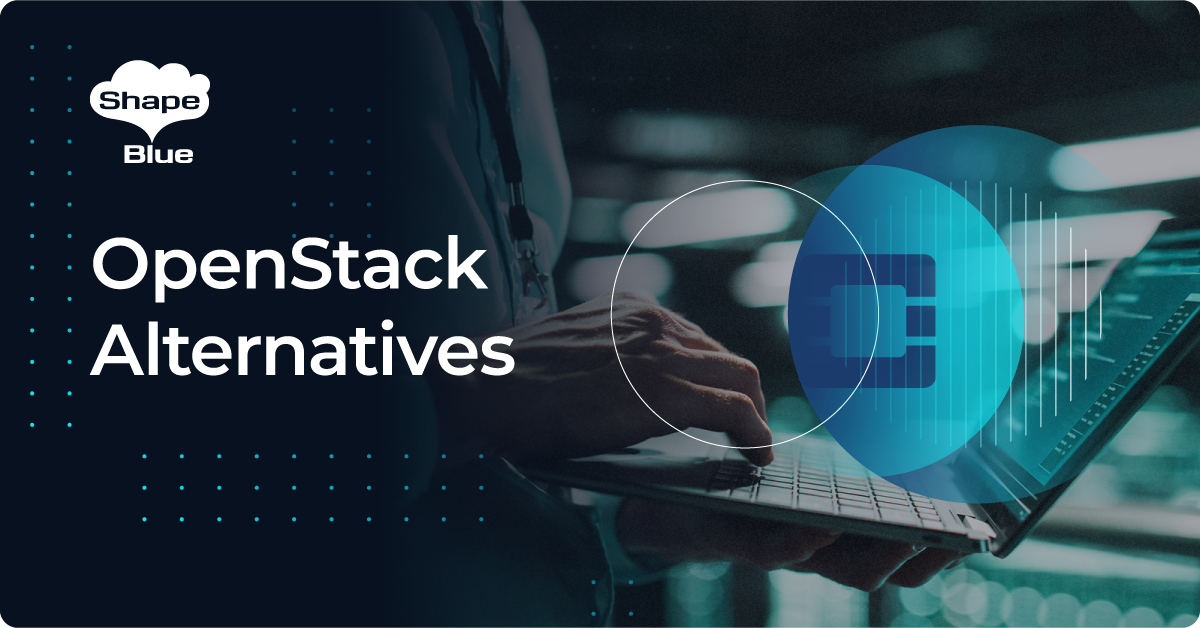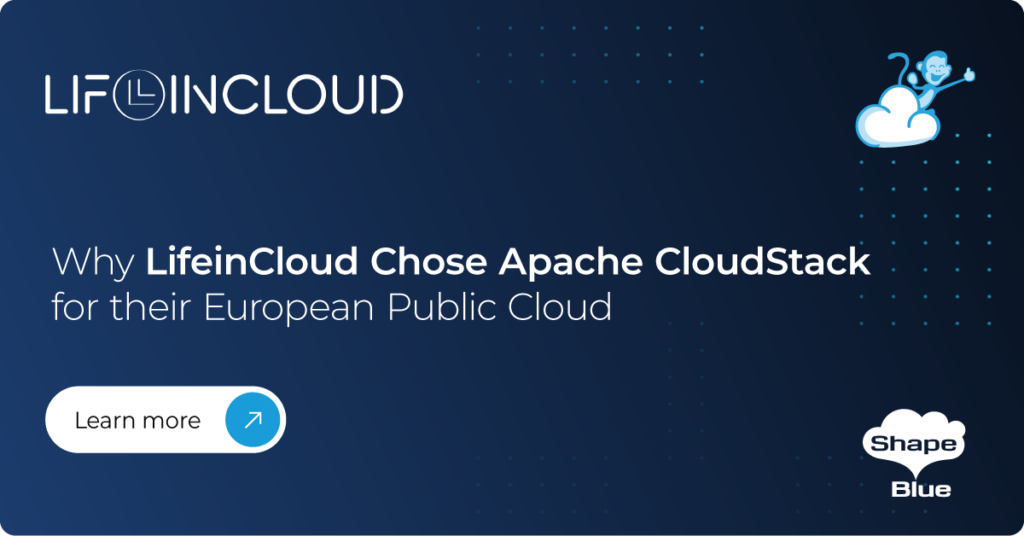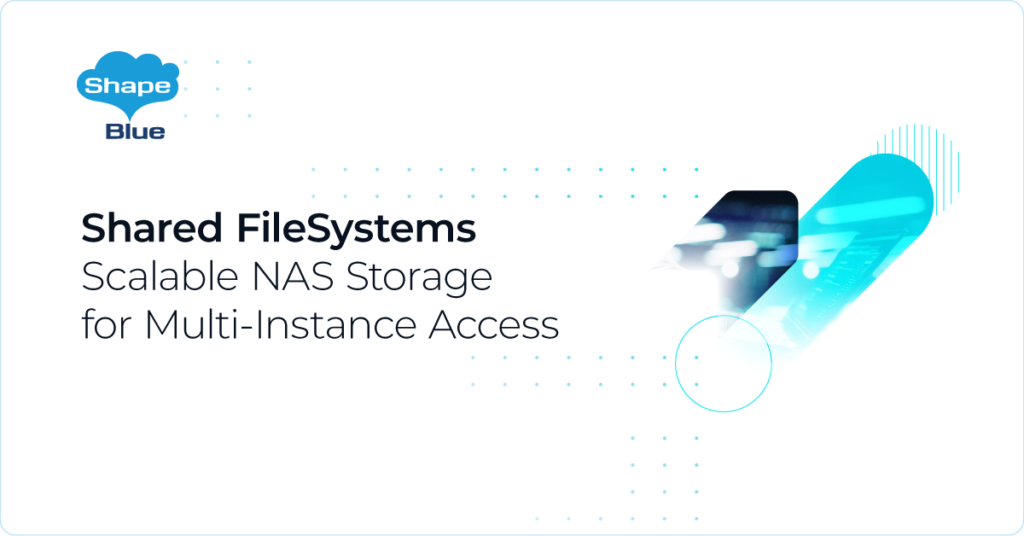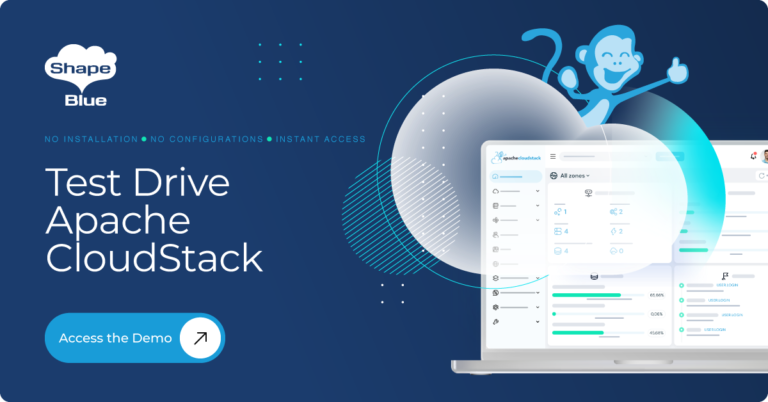OpenStack has been a prominent open-source platform for establishing and managing public and private clouds, comprising a range of integrated projects. While known for its modularity, enabling tailored deployments, many users face issues regarding complexity, resource intensiveness, stability concerns, and challenging upgrades. As a result, organizations are exploring OpenStack alternatives. This article provides insights into the top alternatives to OpenStack – Apache CloudStack, VMware vCloud, and OpenNebula, detailing their key features and advantages for organizations seeking more streamlined and efficient cloud solutions.
OpenStack is an open-source cloud computing platform designed to facilitate the creation and management of both public and private clouds. It is a collection of integrated projects, each serving a specific purpose in the cloud infrastructure. These projects range from computing (Nova) to storage (Swift and Cinder) to networking (Neutron) and more.
Founded in 2010 by Rackspace Hosting and NASA, OpenStack has grown exponentially, supported by a vast community of developers and backed by some of the biggest names in the IT industry. Its modular architecture allows organizations to deploy only the components they need, making it a flexible solution for diverse cloud requirements. Although its modularity is promoted as an advantage, it brings many drawbacks for OpenStack users, who complain about its complexity and costs to deploy and operate. The multitude of components in OpenStack can pose challenges for organizations in terms of setup and management, necessitating investments in training and support.
In addition, OpenStack can be resource-intensive, requiring substantial computing power, storage, and memory to operate efficiently. This can be a significant factor for companies looking for cost-efficiency. When you add on top of all the challenges of updates and maintenance, lack of standardization and difficulties when integrating with third-party solutions, many companies recently are considering an OpenStack alternative rather than spending months on learning and doing PoCs.
OpenStack Architecture Characteristics
OpenStack is a complex cloud computing platform, and its architecture is composed of many interrelated modules. Each OpenStack module is responsible for performing specific tasks. Below is a list of the functions of the main modules:
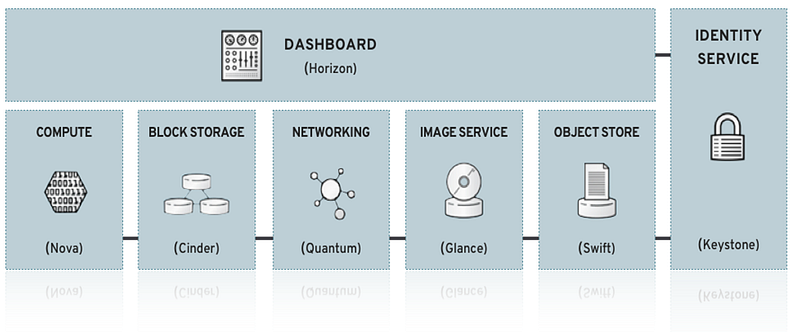
Source: OpenStack Documentation: https://docs.openstack.org/security-guide/introduction/introduction-to-openstack.html
OpenStack is a complex cloud computing platform, and its architecture is composed of many interrelated modules. Each OpenStack module is responsible for performing specific tasks. Below is a list of the functions of the main modules:
- Nova (Compute)
Nova is the primary compute engine behind OpenStack. It manages and automates the deployment of instances upon request. It has full support for KVM and partial support for VMware and Hyper-V. Nova uses the Magnum and Zun sub-projects to manage container services like Kubernetes.
- Cinder (Block Storage)
Cinder provides persistent block storage to running instances. Its architecture is designed to allow third-party storage providers to create drivers, enabling their storage platforms to work with Cinder. It informs the path and location of the Nova compute module through a message queue service.
- Neutron (Networking)
Neutron provides a scalable and API-driven system for managing networks and IP addresses within OpenStack. It ensures that the network is not a limiting factor in a cloud deployment and gives users self-service ability over their network configurations. Neutron supports a variety of networking models, including flat networks, VLANs, and VXLANs, and allows for third-party plugins to extend its capabilities.
- Glance (Image Service)
Glance offers discovery, registration, and delivery services for disk and server images. It can store these images in a variety of backends, including OpenStack Object Storage. Users can take snapshots of their instances or create new images and save them back to Glance. It plays a crucial role in instance provisioning.
- Swift (Object Storage)
Swift is responsible for storing and retrieving arbitrary unstructured data objects, such as disk images, backups, and data archives. It often works in combination with the Glance sub-project to store templates, disk snapshots, and ISO images.
- Keystone (Identity)
The Keystone module provides identity, token, catalogue, and policy services for OpenStack. It handles API client authentication, service discovery, and distributed multi-tenant authorization.
- Horizon (Dashboard)
Horizon is the canonical implementation of OpenStack’s Dashboard, providing a web-based user interface to other OpenStack services. While it offers a graphical interface, it doesn’t cover all operational functions, and users often need to rely on the command-line interfaces of individual sub-projects.
- Ceilometer (Telemetry)
The Ceilometer module collects and stores OpenStack performance measurements. It provides the ability to normalize and transform data across all major current OpenStack components.
- Heat (Orchestration)
The Heat module provides orchestration services for OpenStack. It allows users to define and manage infrastructure as code, automating the creation of resource stacks.
Fundamental Features in OpenStack
Below, we outline the fundamental features that characterize OpenStack, giving you a deeper understanding of your potential applications in cloud operations. Let’s take a closer look at these vital characteristics:
- Modularity and Flexibility
OpenStack is characterized by its modular and flexible architecture, enabling organizations to sculpt their infrastructure to align with specific operational directives. This framework allows organisations to bring together the modules described above to create a cloud infrastructure that meets their organizational needs.
- Scalability
OpenStack has a scalable architecture, a trait that is considered when choosing platforms for developing cloud infrastructures. It can handle a significant number of virtual machine instances, storage volumes, and network connections, accommodating organizations of various sizes. Its distributed architecture facilitates the incremental addition of resources as demand increases, allowing for horizontal scaling and expansion across different geographical locations. This structure aims to assist organizations in managing increased traffic and positioning services nearer to their user base.
- Networking
OpenStack provides a range of networking options, assisting organizations in developing intricate network configurations with a degree of ease. The platform supports advanced networking functionalities, including Quality of Service (QoS), firewall, and VPN capabilities, offering a solid foundation for safeguarding and optimizing network traffic, with the aim of maintaining secure data transmission and communication.
- Multi-Tenancy
The multi-tenancy capability in OpenStack is a fundamental aspect of its structure, permitting the establishment of multiple separate environments within a single infrastructure. This feature is intended to assist organizations in distributing resources wisely while upholding strict security and isolation measures for each tenant. It is a potentially beneficial feature for organizations serving varied customer groups or departments, as it seeks to streamline resource management and enhance security.
- Automation
OpenStack incorporates several automation features intended to facilitate the management and allocation of resources. These functionalities are designed to help organizations automate common tasks, such as setting up virtual machine instances and establishing network connections, potentially saving time and resources. This automation aspect is also expected to enhance the scalability and management of resources, promoting a potentially more adaptable infrastructure.
- Community and Vendor Support
OpenStack is backed by a community that includes developers, users, and various vendors. This community serves as a resource pool, contributing to the ongoing development and enhancement of OpenStack. Additionally, there is a range of vendors offering commercial support for OpenStack, providing technical assistance and customized solutions that can aid in the integration and operation of OpenStack in different infrastructure settings. This combination of community input and vendor support aims to provide organizations with a network of resources and support when utilizing OpenStack’s features. On the other hand, this means that it is rarely possible to use OpenStack without going for vendor distribution and engaging with a support contract from one of the companies in the OpenStack ecosystem.
Why are Organizations Looking for OpenStack Alternatives?
Organizations may seek alternatives to OpenStack for various reasons, often stemming from the challenges they face with the platform. Based on our experience and feedback from companies switching from OpenStack to Apache CloudStack, we can state the following reasons why organizations can look for alternatives to OpenStack:
High Level of Complexity
One of the most frequently cited challenges with OpenStack is its complexity. Setting up, configuring, and maintaining an OpenStack environment requires a deep understanding of its components and their interdependencies. It often requires a team with skills in systems administration, networking, and software development, particularly with experience in Python, as many OpenStack components are developed in this language. Moreover, a solid grasp of cloud computing concepts and security protocols is essential. Organizations without a team possessing these specialized skills might find managing an OpenStack environment to be a daunting task, potentially facing steep learning curves and operational hurdles.
Resource Intensiveness
Deploying and maintaining OpenStack can be resource-intensive, both in terms of hardware and manpower. Smaller organizations or those without a dedicated team might find it challenging to allocate the necessary resources.
According to feedback from users, a minimum of 6 servers are required to perform an OpenStack installation. You’ll also need a dedicated block device on nodes meant to host the storage. Preferably, maintaining the OpenStack modules in separate servers is recommended.
Stability Concerns
Some users have reported stability issues, especially when using newer or less-tested modules. Downtime or service interruptions can be costly, leading them to seek more stable alternatives.
Upgrade Challenges
Upgrading OpenStack is often perceived as a daunting task, primarily due to its intricate and modular structure. Here are several aspects that contribute to the complexity of the upgrade process:
– Interdependencies of Components
OpenStack consists of various interdependent components. An upgrade in one module might necessitate changes or upgrades in others to maintain compatibility, making the process more complex and time-consuming.
– Custom Configurations
Many organizations customize OpenStack to suit their specific needs. During an upgrade, these custom configurations can create conflicts, potentially leading to system instability or failures.
– Database Migrations
Upgrades often involve database migrations, which, if not managed meticulously, can result in data loss or corruption.
– Downtime
Depending on the extent of the upgrade, there might be significant downtime, which can disrupt operations and impact business continuity.
– Testing and Validation
Before fully implementing an upgrade, extensive testing is necessary to identify and mitigate potential issues. This phase can be resource-intensive, requiring both time and expertise to ensure a smooth transition.
– Documentation and Knowledge Transfer
Given the complexity of OpenStack environments, maintaining detailed documentation of the system’s configuration and changes made during the upgrade is vital. This documentation is crucial for troubleshooting potential issues and facilitating knowledge transfer within the team.
Organizations contemplating OpenStack upgrades need to be prepared for these challenges, allocating sufficient time, resources, and expertise to ensure a successful transition. Those seeking more straightforward upgrade paths might explore alternatives that offer a more streamlined, less complex upgrade process.
Talent Shortage
Although there are a considerable number of professionals on the market with OpenStack skills, managing an OpenStack cloud can be a substantial challenge due to the large number of specialists needed and considering that demand is higher than the offer. The modular and interdependent nature of OpenStack requires an organization to maintain an internal team with experience in OpenStack architecture and components. Even small oversights can lead to critical issues, underscoring the need for a well-qualified team for effective operation and management.
Integration Hurdles
OpenStack’s modular structure, while offering a range of functionalities, can sometimes pose significant hurdles when it comes to integration, particularly with legacy systems or proprietary software. The integration process often demands a deep understanding of the OpenStack components and their interdependencies. Moreover, it might need custom solutions to ensure seamless interoperability between different systems, which can be resource-intensive and time-consuming. Organizations might, therefore, consider alternatives that promise more straightforward and less labour-intensive integration paths, to streamline operations and reduce the potential for integration-related issues.
Cost Considerations
While OpenStack itself is theoretically open-source and can be cost-effective, the total cost of ownership, including hardware, manpower, training, and potential downtime, might lead organizations to evaluate if other solutions offer better value. As we mentioned above, often companies using OpenStack need to sign a support contract with one of the vendors within the ecosystem.
Seeking Comprehensive Solutions
Some organizations might prefer turnkey solutions or platforms offering a more comprehensive set of features out of the box, without requiring extensive customization or additional modules.
Vendor Dependencies and Lock-in
While OpenStack itself is open-source, in practice, many organizations find it necessary to rely on vendor distributions of OpenStack to ensure stability, support, and ease of management. These vendor distributions often come with dedicated support, SLAs, and regular updates, but this comes at a significant cost. Moreover, opting for vendor distribution can lead to vendor lock-in, limiting the organization’s flexibility to switch to different platforms or customize the solution to their specific needs. This dependency on vendors not only escalates costs but also potentially restricts the organization’s ability to fully leverage the open-source nature of OpenStack, as they find themselves bound by the specific implementations and tool integrations offered by their chosen vendor. Therefore, organizations considering OpenStack should be prepared to navigate the complexities of vendor relationships, including potential lock-in and the associated costs.
While OpenStack offers numerous advantages, it’s essential for organizations to evaluate their specific needs, resources, and long-term goals when choosing a cloud platform. For some, the challenges might outweigh the benefits, leading them to consider alternatives.
Top 3 OpenStack Alternatives
Below, we present a list of the top 3 OpenStack competitors with a short review of their advantages and key value propositions. Comparing virtualisation management platforms can be hard, so dive deep into our technical review.
Apache CloudStack
Overview
Apache CloudStack is a robust open-source cloud computing platform that facilitates the comprehensive management and orchestration of virtualized servers, networks, and storage environments. It is designed to be highly scalable, making it a suitable choice for service providers, enterprises, and other organizations looking to build and manage cloud infrastructure with a focus on simplicity and integrated functionalities.
CloudStack offers a centralized management dashboard, where users can configure and manage their cloud computing environments with relative ease. It supports a wide range of hypervisors, including VMware, KVM, XCP-ng and XenServer, allowing for a flexible and adaptable infrastructure setup.
Key features
By offering a cohesive and integrated solution, CloudStack aims to reduce the complexity often associated with cloud infrastructure management, making it a viable option for organizations seeking a straightforward path to deploying and managing a cloud environment.
1. Turnkey solution – Apache CloudStack offers all of its functionality “out of the box” as an open-source product. There is no requirement to have dedicated teams or buy a vendor distribution.
2. Multi-Tenant Support – CloudStack supports multi-tenancy, enabling organizations to create isolated cloud environments for different departments or clients, ensuring security and resource allocation efficiency.
3. High Availability – Designed to minimize downtime, CloudStack incorporates automatic failover and recovery mechanisms to maintain the high availability of services, even in the event of system failures.
4. Resource Orchestration – CloudStack provides comprehensive resource orchestration capabilities, allowing for the automated provisioning and management of computational, storage, and network resources. It supports a wide range of hypervisors, including VMware, KVM, XenServer, and XCP-ng.
5. Scalability – CloudStack’s architecture is hugely scalable, it is regularly used from micro-cloud deployments (with only a single host needed for a POC) to environments with 10,000’s of physical hosts.
6. API Accessibility – CloudStack offers a rich set of APIs, facilitating seamless integration with existing IT environments and enabling automation of various cloud management tasks.
7. Network Management – CloudStack offers advanced network management features, including Virtual LAN (VLAN) support, load balancing, and firewall configurations, to create a secure and optimized network infrastructure. It also integrates with SDN platforms.
8. User-Friendly Interface – CloudStack features a user-friendly web interface, simplifying the process of managing and monitoring cloud resources and reducing the learning curve for new users.
VMware vCloud
Overview
VMware vCloud, a prominent player in the cloud computing sector, offers a comprehensive platform that facilitates the seamless creation, management, and deployment of virtualized networks and services. It is particularly favoured by enterprises and service providers for its robust capabilities in orchestrating complex, multi-faceted cloud environments. Leveraging VMware’s strong background in virtualization technology, vCloud is structured to offer high scalability and reliability, making it a preferred choice for organizations aiming for a streamlined yet powerful cloud infrastructure solution.
vCloud presents a centralized management console, where users can effortlessly configure and oversee their cloud computing setups. It supports integration with various VMware products and other industry-standard hardware, fostering a versatile and adaptable infrastructure configuration.
Key Features
By delivering a unified and integrated solution, VMware vCloud stands as a reliable choice for organizations looking for a sophisticated yet user-friendly approach to building and managing a cloud infrastructure, aligning with both current and future business objectives.
1. Enterprise-Grade Security – VMware vCloud is renowned for its robust security features, providing multi-layered protection to safeguard data and applications within the cloud environment, thus ensuring business continuity and compliance with industry standards.
2. High Scalability – vCloud is designed with scalability at its core, allowing organizations to easily expand their cloud infrastructure in line with business growth, without compromising on performance and efficiency.
3. Resource Optimization – The platform offers advanced resource optimization tools that facilitate the efficient allocation and management of computing, storage, and network resources, enhancing overall operational efficiency.
4. API Integration – VMware vCloud boasts extensive API accessibility, enabling smooth integration with existing IT setups and automating a wide range of cloud management operations, thus fostering a cohesive IT ecosystem.
5. Advanced Network Management – vCloud provides sophisticated network management capabilities, including support for Virtual LANs (VLANs), load balancing, and advanced firewall configurations, to establish a secure and high-performing network infrastructure.
6. Intuitive User Interface – The platform features an intuitive user interface that simplifies the cloud management process, offering a user-friendly experience that reduces the learning curve for newcomers while providing depth for experienced users.
By delivering a unified and integrated solution, VMware vCloud stands as a reliable choice for organizations looking for a sophisticated yet user-friendly approach to building and managing a cloud infrastructure, aligning with both current and future business objectives.
OpenNebula
Overview
OpenNebula is an open-source cloud computing platform offering a streamlined solution for the management and orchestration of virtualized resources. It is particularly suited for SMEs and organizations aiming to establish a private or hybrid cloud infrastructure with a focus on simplicity and efficiency. OpenNebula’s architecture is designed to be flexible and adaptable.
OpenNebula features a centralized management interface where users can easily configure and manage their cloud computing setups. It supports a variety of hypervisors, including KVM and VMware, allowing for a flexible infrastructure setup that can be tailored to the specific needs of an organization.
Key Features
1. Simplified Cloud Management – OpenNebula offers a simplified approach to cloud management, enabling organizations to efficiently create and manage virtualized environments without the complexity often associated with larger cloud platforms.
2. Resource Scalability – Designed with scalability in mind, OpenNebula allows organizations to dynamically allocate and manage resources, adapting to changing demands and ensuring optimal performance at all times.
3. Integrated Toolset – OpenNebula provides an integrated toolset for resource orchestration, facilitating the automated provisioning and management of computational, storage, and network resources, thus enhancing operational efficiency.
4. API Accessibility – OpenNebula features a robust set of APIs, fostering seamless integration with existing IT environments and enabling the automation of various cloud management tasks, thus promoting a cohesive IT ecosystem.
5. Flexible Network Management – The platform offers flexible network management capabilities, including support for Virtual LANs (VLANs), load balancing, and firewall configurations, to establish a secure and optimized network infrastructure.
6. User-Centric Interface- OpenNebula boasts a user-centric interface that simplifies the process of managing and monitoring cloud resources, offering a streamlined user experience that reduces the learning curve for new users while providing depth for experienced users.
By offering a balanced and integrated solution, OpenNebula serves as a viable option for organizations seeking a straightforward yet versatile approach to deploying and managing a cloud environment, aligning well with various business requirements and objectives.
OpenStack Alternatives Side-by-Side Technical Comparison
| Aspect | OpenStack | CloudStack | VMware vCloud | OpenNebula |
| Architecture | Modular, with several interdependent components like Nova, Swift, and Neutron. | Monolithic compared to OpenStack, offering a turnkey solution. | Proprietary, integrates seamlessly with other VMware products, offering a comprehensive solution. | Modular and flexible, allowing for integration with various hypervisors and cloud services. |
| Ease of Use | Known for a steep learning curve, requiring deep understanding of its components. | Generally considered more user-friendly with a simple setup and management process. | It offers a more streamlined user experience but might have a steeper learning curve for those unfamiliar with VMware products. | Offers a user-friendly interface with a focus on simplicity and ease of use. |
| Community Support | Large, active community contributing to development and providing support. However, most organisations use vendor distribution due to complexity. | Has a smaller but steadily growing community, fostering innovation and collaboration. | Supported by VMware’s extensive network and resources, offering robust support and development. | Has a growing community and open-source development, fostering collaboration and innovation. |
| Scalability | It can scale horizontally to support a large number of nodes, suitable for large organizations. | Highly Scalable, considered suitable for all-sized cloud deployments. | Highly scalable, suitable for both medium and large enterprises with complex needs. | Scalable, with a focus on providing efficient resource management for various sizes of cloud deployments. |
| Integration | It can integrate with modern enterprise and open-source technologies, though it can be complex. | Offers easier integration paths, especially with existing legacy systems and proprietary software. | Integrates well with other VMware products and offers advanced features for hybrid cloud capabilities. | Allows for easy integration with existing IT infrastructure and supports various cloud models. |
| Upgrade Challenges | Upgrades can be complex, with the potential for breaking changes or incompatibilities. | Upgrades are generally smoother, with fewer breaking changes, facilitating easier maintenance. | Upgrades are managed through VMware’s comprehensive support structure, offering smoother transitions between versions. | Offers straightforward upgrade paths, minimizing potential disruptions and incompatibilities. |
| Resource Requirements | Requires significant resources and expertise for deployment and maintenance. | It requires fewer resources for setup and management, making it a more cost-effective solution. | Requires substantial investment in both resources and expertise for optimal deployment and management. | Offers a more streamlined resource management approach, reducing the complexity of deployment and maintenance. |
| Vendor Support | Most organizations use vendor distributions, which come with associated costs and potential vendor lock-in. | Users generally use the “pure” open-source version with vendor support options, avoiding potential vendor lock-in. | Comes with dedicated vendor support, SLAs, and regular updates, but at a higher cost and with the potential for vendor lock-in. | Offers flexible vendor support options, allowing for a balance between community and commercial support. |
| Talent Requirements | Requires a team with deep expertise in OpenStack architecture and components. | Requires a smaller team with expertise in cloud computing, potentially easing the hiring process. | Requires a team with expertise in VMware products, potentially necessitating a larger team with specialized skills. | Requires a team with expertise in cloud computing, with a focus on open-source technologies and integrations. |
| Stability | Some users report stability issues, especially with newer releases. | Generally considered more stable and robust, with fewer issues reported in terms of stability. | Known for enterprise-grade reliability and performance, offering a stable solution for complex cloud environments. | Has had instances of stability concerns in certain configurations, requiring careful setup and monitoring. |
| Cost Efficiency | It can potentially reduce costs as it avoids the need for proprietary software. | Offers a cost-effective solution, especially for organizations with limited resources. | It can be more expensive compared to open-source alternatives due to its proprietary nature. | Offers a cost-effective solution, with options for both open-source and commercial deployments. |
OpenStack Components Alternatives
- OpenStack Heat
Tools like Terraform or Apache Brooklyn can be used for infrastructure orchestration and automation.
- OpenStack Ceilometer
Solutions like Prometheus or Grafana can be integrated for monitoring and telemetry.
- OpenStack Trove
Solutions like Amazon RDS or self-hosted solutions like MySQL or PostgreSQL can be utilized.
- OpenStack Swift
Apache Cassandra, Ceph Object Gateway or MinIO can be considered for object storage.
- OpenStack Neutron
While CloudStack has its own networking management and SDN technologies, solutions like Calico or Cilium can be explored for advanced networking functionalities.
- OpenStack Ironic
Solutions like Rancher or Metal3 can be considered for bare metal provisioning.
- OpenStack Zun or Magnum
Alternatives: Kubernetes is the standard choice for container orchestration and can be integrated alongside other platforms. Also, Cluster API and CloudStack Container Service (CKS) are already integrated with Apache CloudStack.
Apache CloudStack as an OpenStack Alternative
Apache CloudStack presents itself as a compelling alternative to OpenStack for several reasons:
Simplified Architecture
CloudStack is characterized by its simplified architecture, which facilitates easier deployment and management. Unlike OpenStack, which operates through numerous interdependent modules, CloudStack adopts a more streamlined and integrated approach. This makes it a more accessible option for organizations with varying levels of cloud expertise, potentially reducing the time and resources required for setup and ongoing management.
Community Influence on Roadmap
CloudStack boasts a vibrant and responsive, user-led community that actively participates in the platform’s development. The community is governed by The Apache Software Foundation, and vendors are prevented from over-influencing the project. Community engagement allows users to have a significant influence on the roadmap, proposing new features and enhancements and fostering a collaborative and user-centric development environment.
Multi-Hypervisor Support
One of CloudStack’s standout features is its multi-hypervisor support, accommodating various hypervisors, including VMware, KVM, XCP-ng, and XenServer. This flexibility enables organizations to seamlessly integrate and leverage their existing infrastructure investments, offering a versatile foundation for cloud computing setups.
Vendor-Neutral Environment
CloudStack offers the significant advantage of avoiding vendor lock-in, allowing organizations not to be confined to a single vendor’s technology and pricing structure. This vendor-neutral approach promotes greater flexibility and potential cost savings, as organizations are not bound to constant payments and can adapt their infrastructure according to evolving needs and preferences.
Extensive Third-party Tool Integration
CloudStack showcases compatibility with a broad spectrum of third-party tools and platforms. This includes infrastructure automation tools like Terraform, ClusterAPI for Kubernetes cluster management, and monitoring solutions such as Prometheus. It has the broadest hypervisor support and deep integrations with many storage platforms. Its support for the S3 protocol for object storage and various Software-Defined Networking (SDN) solutions further accentuates its flexibility and ease of integration into diverse IT ecosystems.
User-Centric Interface
CloudStack presents a user-friendly interface that simplifies cloud management tasks. This intuitive platform allows administrators to monitor and manage cloud resources efficiently, reducing the learning curve for new users and enhancing the overall user experience.
Cost-Effectiveness
Being open-source, CloudStack can potentially lead to reduced costs in terms of setup, training, and ongoing management. Moreover, its ability to integrate with existing systems can further mitigate costs associated with infrastructure investments, making it a cost-effective solution for organizations of various sizes.
Technical Innovations
CloudStack is committed to introducing technical innovations that enhance its functionality and user experience. Its dedication to adopting the latest technological advancements ensures that users have access to cutting-edge features and capabilities, fostering a dynamic and forward-thinking cloud computing environment.
In conclusion, while OpenStack offers a modular and flexible approach to cloud management, its complexity can be a deterrent for many organizations. Apache CloudStack, with its integrated and user-friendly approach, emerges as a viable alternative for organizations seeking a more straightforward and cost-effective cloud solution. CloudStack underpins the public cloud services of many global service providers and is used by some of the world’s largest companies to deliver private cloud.
Marco Sinhoreli is a seasoned Technical Marketing Manager at ShapeBlue, with over 25 years of IT experience. As an Apache CloudStack expert and committer, he specializes in creating and delivering technical marketing content that bridges the gap between technology and business. Marco has consulted major companies on implementing IaaS solutions with CloudStack, focusing on delivering cloud infrastructure that supports both immediate and long-term business needs. When he’s not diving into cloud solutions, Marco loves playing guitar, exploring new places, and staying updated on politics.
